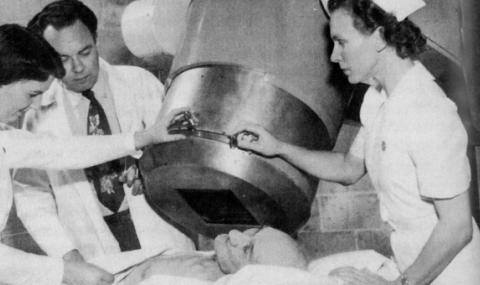en is a LAP (left
|
|
re) used, and what p
recautions are needed?
Answer:
Pulsus Paradoxus (reversed due to mechanical ventilation). This patient was hypovolemic.
Criteria:
- The systolic blood pressure fluctuates with breathing (note that this is different than pulsus alternans, where the rhythm is regular but the systolic pressure alternates between one strong and one weak stroke volume).
- R - R interval on ECG and systolic - systolic interval on the arterial line are regular, ruling out arrhythmia as the cause for the fluctuating systolic pressure.
- There is a difference of greater than 15 mmHg between inspiratory and expiratory systolic pressures.
Definition:
During spontaneous breathing, the negative pleural pressure against the heart during inspiration produces a slight increase in transmural pressure and afterload. This causes a small decrease in ventricular ejection with systole. Thus, in normal breathing, systolic blood pressure can normally fall on inspiration by 10 mmHg.
Pulsus paradoxus is an exaggeration of this normal blood pressure variation with breathing. It is defined as a fall in systolic pressure by more than 15 mmHg during spontaneousinspiration. Kussmaul first described this phenomena by noting the paradoxical disappearance of the arterial pulse during inspiration in the presence of a normal heart beat.
Causes:
Causes for pulsus paradoxus includes severe cardiac decompensation and cardiac tamponade. Approximately 50% of patients with constrictive pericarditis, obstructive airway disease or asthma will have pulsus paradoxus. It can also occur in hypovolemic shock, pulmonary embolism, alveolar hyperinflation or tension pneumothorax.
In a mechanically ventilated patient, a reversal of this pressure variation occurs. Positive pressure ventilation displaces the ventricle wall inward during systole to assist in ventricular emptying. This causes a slight rise in the systolic pressure during mechanical inspiration.
Reversed Pulsus Paradoxus is defined as an exaggeration of the rise in systolic BP during mechanical inspiration. A rise in peak systolic pressure on mechanical inspiration by more than 15 mmHg is considered significant.
Causes:
A reverse pulsus paradoxus in a mechanically ventilated patient is sensitive indicator of hypovolemia. It can also be present in cardiac tamponade, obstructive airway disease, severe cardiac deterioration, pneumothorax, asthma or pulmonary hyperinflation.
Brenda Morgan: January 7, 2000, Revised January 8, 2019
References:
Daily, E., & Schroeder, J. (1994). Techniques in Bedside Monitoring. Mosby: Toronto. p. 23, 155-54, 157.
Marino, T. (1998). The ICU Book. Williams and Wilkins: Toronto. p. 8-9, 255.
Schaller, M., and Tagan, D. Acute Bronchospasm in The Oxford Textbook of Critical Care, editors Webb, A., Shapiro, M., Singer, M., and Suter, P. Oxford Medical Publications: London, England. p. 87.
|
|




